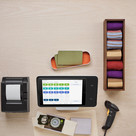As a small-business owner, chances are your business and personal lives are inextricably tied in any number of ways. You most likely tool around in your car or truck, meeting with clients or delivering that next big shipment to the post office.
The good news is that you can write off the use of your automobile for business. The slightly less good news is that taking automobile-related deductions isn’t as easy as just hanging on to your receipts.
Courtesy of our friends at TaxJar, here’s the need-to-know about taking an automobile deduction on your small-business taxes. (Remember, this post is for educational purposes only. For tax advice related to your small business, make sure to consult a reputable accountant).
Pick your auto deduction poison
You can deduct all the instances where you use your personal automobile for business purposes, but this means choosing one of two methods:
The standard mileage rate deduction
With this method, you simply keep a log of the miles you drove to meet with a client, deliver a package, or do some other business-related service. From there, you can take the IRS standard deduction of 56 cents per mile. (This amount changes every year, so be sure to keep up to date.)
To log your mileage, be sure to write down:
- Date of the trip
- Purpose of the trip
- How many miles you drove
To take this deduction, just add up all the miles you drove for business throughout the year, multiply it by the 2014 IRS mileage rate of 56 cents, and there’s your deduction amount.
To automate the process, you can also check out a handy app like MileBug.
The actual expense deduction
This method allows you to deduct “actual expenses” made for the operation of your vehicle, including:
- Gas
- License and registration fees
- Insurance
- Maintenance and repairs
- Payments or lease payments
- Depreciation
- Garage rent
- Tires
- Tolls and parking fees
That said, if you use only one vehicle for business and personal use, this method can get a little tricky. For example, if you use your car for 50 percent business and 50 percent personal, then you can write off 50 percent of the business use of your car. It’s important that you document the business use of your vehicle so you can prove that you use it 50 percent of the time for business in case of an audit.
Which auto deduction is right for you?
Still not quite sure which method to use? Here are a couple of tips:
You’ll often benefit from the standard mileage deduction if you drive a large number of miles for business, drive an older or smaller car, or drive a vehicle with great gas mileage.
If you drive a newer, larger vehicle or something like a work truck with high operating costs, then you’ll benefit from the actual expense deduction.
One pro tip, which requires a little more effort but could result in big tax savings, is to calculate both deductions and see which one benefits you the most. And, as always, consult an accounting pro if you have questions or concerns about your small-business taxes.
Which auto-related deduction do you take in your business? Why did you choose that method? Start the conversation on Twitter.
About TaxJar
Sales tax is complex. That’s why we created TaxJar — to handle the burden of sales tax while you get back to running your business. TaxJar pulls in sales tax collected from all the channels where you sell, compiles your data into return-ready reports, and can even AutoFile your sales tax returns for you in 26 states (and counting). Sign up for a 30-day TaxJar free trial today and put a lid on sales tax. And check out Square App Marketplace for more information on how to link your Square account to TaxJar’s tools.
![]()











